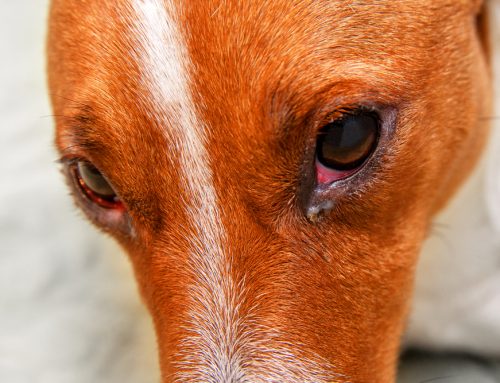Cancer is defined as a “growth or tumor resulting from the division of abnormal cells.” Cancers can arise from virtually any body tissue, and the skin is no exception. While as many as 80 percent of skin tumors in dogs are benign, any abnormal growth should be evaluated by our veterinary team. Read on for a profile of four frequent skin cancers of dogs and cats, including common breeds, clinical signs, and treatment options.
#1: Melanoma
Melanoma is a disease of melanocytes, the cells responsible for creating the skin pigment, and can occur in the oral cavity, eye, nailbed, and skin. Most dermal (i.e., skin) melanomas are benign in pets, but those located near mucocutaneous junctions, such as the anus, vulva, or lip margins, typically behave more aggressively.
- Breeds — Scottish terriers, poodles, golden retrievers, and dachshunds are predisposed. Melanoma of the skin is uncommon in cats.
- Clinical signs — Melanomas are solitary pigmented skin tumors that may be small and firm, and that move freely.
- Treatment — Surgical excision is curative for most pets with melanoma on haired skin.
- Prognosis — The prognosis is variable, based on tumor location and biopsy.
#2: Histiocytic cell tumors
Histiocytes comprise a range of immune cells that form in the bone marrow. In general, histiocytic tumors can be benign or malignant, localized or disseminated, and can arise from many different body tissues. Benign cutaneous (skin) histiocytomas are quite common and are most frequently diagnosed in young pets. Malignant, more aggressive cancers, are found in animals of all ages.
- Breeds — Bernese mountain dogs are the poster dog for this disease. Bulldogs, greyhounds, and Scottish terriers are commonly affected, as are cats.
- Clinical signs — Signs vary, based on location and disease malignancy. Classic signs of a benign, cutaneous histiocytoma include a rounded, red, firm, button-like growth on the superficial layers of the skin near the head, neck, ears, or legs.
- Treatment — Your veterinarian may recommend a watch-and-wait approach if she suspects the tumor is a benign cutaneous histiocytoma, as these tumors often spontaneously regress after about 8 weeks. Surgical removal and biopsy offers a definitive diagnosis and may be curative, but are not always necessary.
- Prognosis — Benign cutaneous histiocytomas offer an excellent prognosis. Malignant skin tumors can have a good prognosis if caught early and surgically removed.
#3: Fibrosarcoma
This aggressive tumor originates from the fibrous connective tissue entwined between the skin, muscles, and bones. It is a slow-growing but highly malignant cancer that is more common in cats than dogs. In cats, this cancer is rarely correlated with injections under the skin.
- Breeds — Any breed of dog or cat may be affected. Gordon setters and Irish wolfhounds may be predisposed.
- Clinical signs — Tumors appear as a firm swelling under the skin that may feel attached to deeper structures. They may be solitary or multiple, rounded or shapeless, raised or slightly flat.
- Treatment — Wide, deep surgical excision is needed to completely remove the tumor. Chemotherapy and/or radiation may be recommended if the tumor has spread, or metastasized.
- Prognosis — Due to the cancer’s invasive nature, and the difficulty of complete surgical removal, the prognosis is poor for most pets.
#4: Mast cell tumors

Mast cells are another type of immune system cell whose uncontrolled growth leads to one of the most common skin cancers of dogs. Mast cell tumors can also originate in, or spread to, other body parts. This unique cancer is often deemed the “great imposter,” as skin growths vary wildly in appearance.
- Breeds — Boxers, Boston terriers, pugs, and weimaraners are at a higher risk for this cancer, but any breed is susceptible. Mast cell tumors are less common in cats.
- Clinical signs — Any skin tumor is a potential mast cell tumor, which can be raised, flat, rounded, shapeless, red, hairless, ulcerated, and anything in between. Any mass that rapidly changes size or appearance is a red flag. Some pets may be itchy due to histamine release from the mast cells.
- Treatment — Any suspected mast cell tumor should be surgically excised and submitted for biopsy.
- Prognosis — Grade 1 tumors have an excellent prognosis after surgical removal. Higher grade tumors are more likely to spread to other areas of the body, leading to a poorer prognosis.








Leave A Comment